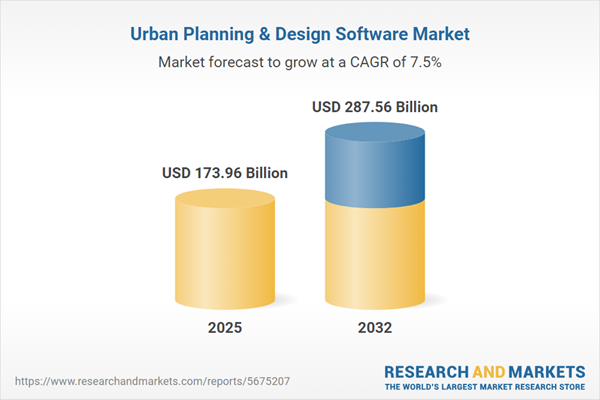Speak directly to the analyst to clarify any post sales queries you may have.
Urban planning and design software is fundamentally transforming how cities navigate regulatory demands, development pressures, and sustainability goals. By enabling informed decisions and seamless collaboration, these solutions are essential for leadership teams seeking modern, adaptable approaches to evolving urban challenges.
Market Snapshot: Urban Planning and Design Software Market Growth
The global urban planning and design software market is experiencing significant expansion, reflected in its current valuation of USD 161.75 billion in 2024. With forecasts projecting growth to USD 173.96 billion by 2025 and a compound annual growth rate (CAGR) of 7.45%, the sector is anticipated to reach USD 287.56 billion by 2032. This strong trajectory is fueled by widespread digital collaboration, integrated project management, and increasing demand for tools tailored to dynamic, urban environments. Market leaders are emphasizing advanced technology adoption and streamlined infrastructure delivery to keep pace with rapid urbanization and increasingly complex compliance requirements.
Scope & Segmentation of the Urban Planning and Design Software Market
This report delivers actionable insights for executive teams aiming to maximize technology ROI and boost project outcomes within urban development. The following segmentation defines strategic focus and current market dynamics:
- Applications: 3D modeling, visualization, workflow management, simulation analytics, geospatial analysis, and site assessment enable accurate planning, support regulatory compliance, and enhance project execution across diverse scenarios.
- End Users: Architects, engineers, construction firms, planning consultants, government agencies, and property developers use these tools to accelerate delivery, control risks, and consistently meet regulatory standards.
- Deployment Modes: Cloud-based, hybrid, and on-premises systems offer flexibility for aligning IT infrastructure with organizational strategies, security requirements, and user preferences.
- Project Types: Infrastructure, commercial, single-family, and multi-family residential projects leverage software to optimize oversight, support scalable rollouts, and adapt to projects ranging from smaller sites to complex developments.
- Pricing Models: Pay-as-you-go, subscription, and perpetual licenses allow organizations to tailor spending and align procurement with project-specific needs or company policies.
- Company Size: Solutions are available for small businesses, midsize organizations, and global enterprises, encouraging comprehensive collaboration regardless of team scale.
- Regions Covered: North America, South America, EMEA, and Asia-Pacific present varying infrastructure demands and regulatory landscapes, with unique opportunities and challenges in countries such as the US, Canada, Brazil, Germany, UAE, China, India, and Australia.
- Key Companies: Major providers such as Autodesk, Hexagon, Trimble, Dassault Systèmes, Esri, Topcon, Bentley, Nemetschek, SuperMap Software, and RIB Software are defining innovation and serving a global client base in urban development.
- Technology Focus: Modern offerings are underpinned by artificial intelligence, machine learning, digital twins, and open data, empowering analytics, real-time monitoring, and enhanced support for effective planning outcomes.
Key Takeaways for Senior Decision-Makers
- Adopting AI and machine learning enables advanced urban planning models and scenario analysis, informing quicker and more effective project decisions.
- Digital twin integration supports simulation and transparency, fostering alignment and agreement among stakeholders during planning cycles.
- Robust collaboration tools streamline teamwork, improve adaptability to new standards, and maintain progress even in shifting regulatory or economic environments.
- Centralized and hybrid data management allows distributed teams to access real-time updates, improving process visibility and cooperation.
- Modular software architectures and flexible deployment make it possible to scale solutions as project needs evolve, ensuring long-term adaptability.
- Customizable licensing structures allow organizations to manage compliance and digital transitions for various business sizes and operational priorities.
Tariff Impact on Market Dynamics
Planned US tariffs taking effect in 2025 are prompting urban planning and design software providers to adjust supply chain logistics and cost structures impacting both software and supporting hardware. Organizations are responding by increasing supply chain resilience, developing modular solution options, and adopting more adaptable licensing approaches. These strategies are crucial for broadening technology access, particularly for small and medium enterprises. Public sector incentives and funding remain pivotal, especially as governments adapt to new regulatory frameworks and drive technology adoption across diverse regions.
Methodology & Data Sources
This assessment combines insights from executive interviews, in-depth secondary analysis, quantitative modeling, and feedback from sector-specific roundtables. The multi-method approach ensures senior decision-makers have a dependable foundation for strategic technology planning.
Why This Report Matters
- Gives leaders a clear understanding of critical market segments, technology adoption, and regional shifts impacting procurement and operational decision-making.
- Supports digital transformation, workflow modernization, and the ability to navigate complex compliance and market barriers with confidence.
- Enables executive teams to align technology investments with business goals, ensuring resilient and efficient urban project outcomes.
Conclusion
This report equips senior stakeholders with timely insights and strategic direction to advance urban development projects with greater resilience, collaborative engagement, and agility amid an evolving global environment.
Additional Product Information:
- Purchase of this report includes 1 year online access with quarterly updates.
- This report can be updated on request. Please contact our Customer Experience team using the Ask a Question widget on our website.
Table of Contents
3. Executive Summary
4. Market Overview
7. Cumulative Impact of Artificial Intelligence 2025
Companies Mentioned
The companies profiled in this Urban Planning & Design Software market report include:- Autodesk, Inc.
- Hexagon AB
- Trimble Inc.
- Dassault Systèmes SE
- Esri, Inc.
- Topcon Corporation
- Bentley Systems, Incorporated
- Nemetschek SE
- SuperMap Software Co., Ltd.
- RIB Software SE
Table Information
| Report Attribute | Details |
|---|---|
| No. of Pages | 199 |
| Published | November 2025 |
| Forecast Period | 2025 - 2032 |
| Estimated Market Value ( USD | $ 173.96 Billion |
| Forecasted Market Value ( USD | $ 287.56 Billion |
| Compound Annual Growth Rate | 7.4% |
| Regions Covered | Global |
| No. of Companies Mentioned | 11 |









